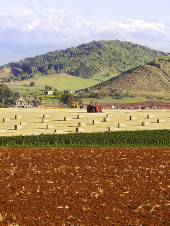- «Home
- «Conservation |
- Cranes on Farms 1
Cranes on Farms 1
Introducing some important habitats for Brolgas and Sarus Cranes on production properties in eastern and northern Australia. Eleven of the world's fifteen crane species are threatened in at least part of their range. Where cranes are surviving or doing well, the keys are good land managment and good relationships with people. Next Cranes on Farms 2» looks specifically at cranes in rice cultivation landscapes.
Farm and pastoral wetlands
Many significant crane sites are wetlands created or modified by pastoralists for stock watering
(E Duignan, Upper Herbert N Qld)

This shallow 12 ha pastoral storage was built in 1972 by pushing an embankment to dam overland Wet season flow. Thousands of waterbirds, including significant Brolga numbers, feed, rest and roost here in the northern winter (the Dry, non-breeding season). This ideal crane flocking habitat has shallow water, surrounded by grassy woodland with moderate grazing to keep grasses short. The Brolgas and some Sarus Cranes feed in neighbouring maize croplands and pasture most of the day. In drought, numbers at this Crane Count site drop to about 200.
Crops and stubbles
A recent interview with the President of the International Crane Foundation, Dr Rich Beilfuss is headlined ‘See a Sandhill? thank a farmer! The impressive recovery of Sandhill Cranes, and more recently the endangered Whooping Crane, in the United States is due to improvements in crane conservation in farmlands and wetlands in many states. He also mentions work with rice farmers in Myanmar and cattle grazing communities in Chad, Africa.
Research on preferred feeding habitats for Atherton Tablelands cranes by Dr John Grant from 1996, and in Dr Tim Nevard's recent PhD study, shows that Atherton Tablelands cranes concentrate on crop stubbles, ploughed land pasture, new-sown crops and wetlands (wetlands more so for Brolgas). For details of their work see John Grant's and Tim Nevard's pages in Ozcranes Research. A key focus for the ongoing annual Crane Counts is the importance of changing agriculture for a significant part of Australia's Sarus Crane population, on the Atherton Tablelands. BirdLife Northern Queensland now includes a day count of Brolgas and Sarus Cranes immediately before the evening roost count, to record crane numbers in different feeding habitats.
Cranes can have completely neutral relationships with cropping, as with this Brolga family walking through lucerne in the New South Wales Riverina.

↑ Sarus Cranes on the Atherton Tableland feed most often in maize stubble Sandy Carroll)
↓ Brolga family in lucerne Matt Herring

Cranes and Grazing
Brolgas on cattle property, Gulf Plains, Queensland (P Merritt)

Cattle coexist well with crane species in many countries. The only known significant breeding area for Sarus Cranes in Australia, in the Gilbert River complex, Gulf Plains, is mostly grazed pastoral land. For guidelines on maximising threatened Brolga habitat on southern Australian grazing properties including farm dams see Matt Herring's work at Murray Wildlife and Inka Veltheim's recent PhD study.
Farmer-crane conflicts
Some crane species have changed wintering areas or migration times to exploit planted seeds and post-harvest crop waste. Cranes feeding on crop waste and vertebrate and invertebrate prey assist farmers, but farmers can face considerable losses when cranes feed on newly planted seed. Conflict may lead to persecution (deliberate harm) to cranes, see Ozcranes Crane Hazards 2». To read about landowner liaison projects aimed at resolving farmer-crane conflicts, check the multi-purpose sites in Resources 1. An important focus of Tim Nevard's PhD study on Brolga-Sarus interactions in northern Australia covers conflicts with farmers, and solutions. Research is continuing on repelling or deflecting cranes from crops.
Irrigation tubing pecked by Brolga, Ord River Irrigation Area, Western Australia (Beeton 1977). The Brolgas were in search of water and the damage makes the tubing unusable.

Some useful references:
- Cranes and Agriculture: A Global Guide for Sharing the Landscape. Austin, Jane E., Morrison, Kerryn L., and Harris, James T., editors. 2018. Baraboo, Wisconsin, USA. Free download from the International Crane Foundation library.
- Agriculture, brolgas and Australian sarus cranes on the Atherton Tablelands, Australia – abstract and references available at the link.
- Farming and cranes on the Atherton Tablelands, Australia – abstract and references available at the link.
- Cranes, Agriculture and Climate Change, Proceedings of a 2010 ICF symposium convened by Wetlands International and the IUCN Crane Specialist Group. Download free from the ICF library, pdf 6.7MB
- Full pdf (1.628 Mb) of B Blackwell, D Helon & R Dolbeer article on crop repellents for pest cranes (pen trial stage)
- The successful ICF research project with universities, government and industry to develop the seed coating Avipel, which creates an emetic effect when cranes feed on new planted seed
- Successful research on feeding stations to deflect cranes from crops, after spectacular buildup in wintering numbers in Israel
- Beeton RJS. 1977. The impact and management of birds on the Ord River development in Western Australia. M.Nat.Res. Thesis. University of New England, Armidale.
- Gowland PN & Royal Australasian Ornithologists Union. 1988. The ecology and management of waterbird pests in the Ord River irrigation area, W.A. RAOU: Moonee Ponds, Vic.
- Working with Zambian community to avoid poisoning of Endangered Grey-crowned Cranes
Next..
Cranes on Farms 2», cranes in rice cultivation



